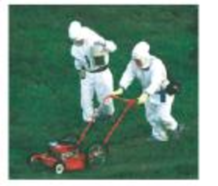
Nightmare on the Island

Peggy loves her time on The Island each year. Her parents had taken her every year to the resort destination as a girl, and now she is doing the same with her children. Their seaside home near Cape Cod, Massachusetts, is modest in comparison to some of the neighbors’, but it has been in Peggy’s family for over a hundred years, and she has fond memories from every stage of her life. One of Peggy’s fondest memories is playing tag with her friends on the lawns of The Island’s homes. Now, she smiles as she watches her eight-year-old son, Jacob, help the older son of one of her childhood girlfriends mow the grassy expanse. “Building memories- that’s what it’s about ,” she muses. Little does she know that some memories can build nightmares.
Three days later Jacob wakes up complaining of a scratchy throat, headache, and “soreness all over.” Peggy is concerned about his dry cough and 103°F temperature. “A summer cold?” she wonders. She keeps Jacob in bed, which isn't difficult because his breathing becomes more labored and painful. Two days later he begins coughing up blood, and Peggy recognizes that this isn’t an ordinary summertime cold.
She rushes Jacob to the local clinic, where the doctor orders immediate intravenous streptomycin and transport to a hospital on the mainland. The physician tells Peggy that Jacob is likely infected with the most virulent bacterium known. He questions her about Jacob’s activities on the island: Has the boy touched any animals? Done any outdoor activities? Been bitten by a tick? “No, no, no.” Then she recalls that Jacob helped mow the grass earlier in the week.
Within days, Jacob feels better and can answer questions. He tells the doctor that the lawnmower had run over the dried body of a small dead rabbit. The physician suspects the mower had spewed bacteria into the air; Jacob had inhaled a near-fatal dose.
The grassy lawn will no longer recall the fond memories of Peggy’s childhood; instead, she will remember men in biohazard suits taking samples, documenting the nightmarish time she almost lost her son.
- 1. What bacterium infected Jacob?
- 2. What is a common name of the disease afflicting Jacob?
- 3. What do the laboratory scientists at the hospital determine about the Gram reaction of the bacterium?
- 4. Why didn’t the physician use penicillin instead of streptomycin?
Want to see the full answer?
Check out a sample textbook solution
Chapter 21 Solutions
Microbiology with Diseases by Body System (5th Edition)
- Every tutor here has got this wrong, don't copy off them.arrow_forwardSuppose that the population from question #1 (data is in table below) is experiencing inbreeding depression (F=.25) (and no longer experiencing natural selection). Calculate the new expected genotype frequencies (f) in this population after one round of inbreeding. Please round to 3 decimal places. Genotype Adh Adh Number of Flies 595 Adh Adh 310 Adhs Adhs 95 Total 1000 fladh Adh- flAdn Adh fAdhs Adharrow_forwardWhich of the following best describes why it is difficult to develop antiviral drugs? Explain why. A. antiviral drugs are very difficult to develop andhave no side effects B. viruses are difficult to target because they usethe host cell’s enzymes and ribosomes tometabolize and replicate C. viruses are too small to be targeted by drugs D. viral infections usually clear up on their ownwith no problemsarrow_forward
- This question has 3 parts (A, B, & C), and is under the subject of Nutrition. Thank you!arrow_forwardThey got this question wrong the 2 previous times I uploaded it here, please make sure it's correvct this time.arrow_forwardThis question has multiple parts (A, B & C), and under the subject of Nutrition. Thank you!arrow_forward
- Calculate the CFU/ml of a urine sample if 138 E. coli colonies were counted on a Nutrient Agar Plate when0.5 mls were plated on the NA plate from a 10-9 dilution tube. You must highlight and express your answerin scientific notatioarrow_forwardDon't copy off the other answer if there is anyarrow_forwardAnswerarrow_forward
- HAND DRAW There should be two proarrow_forwardMolecular Biology Question. Please help solve. Thanks. Please draw how two nucleotide triphosphates are linked together to form a dinucleotide, and label the 5' and 3' ends of the resulting dinucleotide.arrow_forwardWhat is a reversion in molecular biology?arrow_forward
 Medical Terminology for Health Professions, Spira...Health & NutritionISBN:9781305634350Author:Ann Ehrlich, Carol L. Schroeder, Laura Ehrlich, Katrina A. SchroederPublisher:Cengage LearningUnderstanding Health Insurance: A Guide to Billin...Health & NutritionISBN:9781337679480Author:GREENPublisher:Cengage
Medical Terminology for Health Professions, Spira...Health & NutritionISBN:9781305634350Author:Ann Ehrlich, Carol L. Schroeder, Laura Ehrlich, Katrina A. SchroederPublisher:Cengage LearningUnderstanding Health Insurance: A Guide to Billin...Health & NutritionISBN:9781337679480Author:GREENPublisher:Cengage





